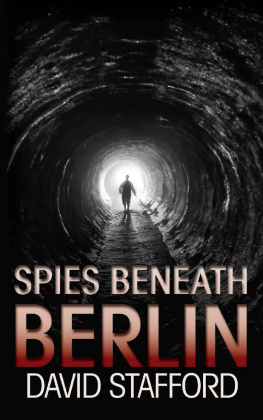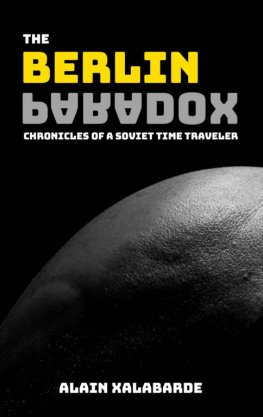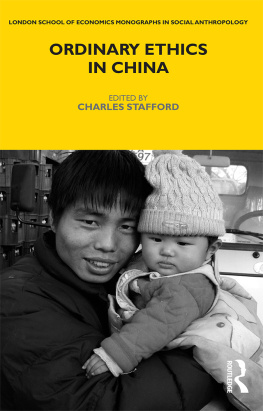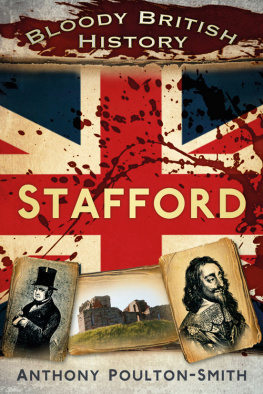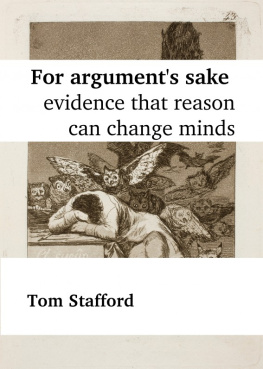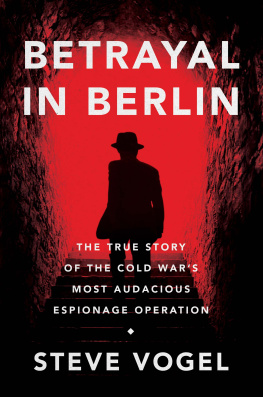David Stafford [Stafford - Spies Beneath Berlin
Here you can read online David Stafford [Stafford - Spies Beneath Berlin full text of the book (entire story) in english for free. Download pdf and epub, get meaning, cover and reviews about this ebook. year: 2013, publisher: Thistle Publishing, genre: Non-fiction. Description of the work, (preface) as well as reviews are available. Best literature library LitArk.com created for fans of good reading and offers a wide selection of genres:
Romance novel
Science fiction
Adventure
Detective
Science
History
Home and family
Prose
Art
Politics
Computer
Non-fiction
Religion
Business
Children
Humor
Choose a favorite category and find really read worthwhile books. Enjoy immersion in the world of imagination, feel the emotions of the characters or learn something new for yourself, make an fascinating discovery.
- Book:Spies Beneath Berlin
- Author:
- Publisher:Thistle Publishing
- Genre:
- Year:2013
- Rating:3 / 5
- Favourites:Add to favourites
- Your mark:
- 60
- 1
- 2
- 3
- 4
- 5
Spies Beneath Berlin: summary, description and annotation
We offer to read an annotation, description, summary or preface (depends on what the author of the book "Spies Beneath Berlin" wrote himself). If you haven't found the necessary information about the book — write in the comments, we will try to find it.
David Stafford [Stafford: author's other books
Who wrote Spies Beneath Berlin? Find out the surname, the name of the author of the book and a list of all author's works by series.
Spies Beneath Berlin — read online for free the complete book (whole text) full work
Below is the text of the book, divided by pages. System saving the place of the last page read, allows you to conveniently read the book "Spies Beneath Berlin" online for free, without having to search again every time where you left off. Put a bookmark, and you can go to the page where you finished reading at any time.
Font size:
Interval:
Bookmark:
Spies Beneath Berlin
David Stafford
Copyright 2013, David Stafford
For my sister Liz, fellow survivor
of the Cold War
Contents
I first thought of writing this book in June 1999, during a walk along the shore of the Starnberger See at Tutzing, outside Munich, during a conference on Germany and Cold War intelligence. My old friend Bill Leary, professor of history at the University of Georgia, gave a brief paper on this legendary operation. German scholars attending the conference were aware of the Berlin tunnel but, like me, knew little about it. Leary himself had no plans for such a book and so, with his encouragement and help, I began.
In the two years that have followed I have also received indispensable help from many other people. While the documentary backbone of the book is furnished by recently declassified Central Intelligence Agency and National Security Agency documents, the all-important flesh was added through personal interviews with key participants in both the Vienna and Berlin operations. Hayden Peake, an invaluable friend in opening doors in the United States, very quickly put me in touch with David Murphy, whose co-authored book Battleground Berlin is an essential starting-point for any study of Cold War intelligence.apparent throughout, although he bears no responsibility for any of my views or mistakes. My thanks, too, go to Walter OBrien and Hugh Montgomery, both of whom took time to see me and whom it was a pleasure to meet. One other CIA participant in the operation also deserves warm mention. During a regrettably brief visit on my part Joseph Evans gave very generously of his recollections as a member of the tunnel intelligence-processing team in London. This was a significant but hitherto largely unknown dimension of the operation and I am particularly grateful for his help.
If my visit to the United States delivered rich rewards, so did that to Berlin. Here Dr Helmut Trotnow, Director of the Allied Museum, which now occupies part of the former American forces compound in the city, was unreservedly hospitable, showed me around the museum and led me on an unforgettable walk along the reconstructed section of the spy tunnel now on display. Here I also met Willie Durie, an indefatigable researcher and incomparable mine of information on the history of the allied presence in Berlin. His constant enthusiasm for this project, and the help he has given me particularly, but by no means exclusively, in providing photographs of the tunnel and other Cold War sites in the city, has been one of the genuine and lasting pleasures of the project.
In addition to all the above, I wish also to thank the following friends and colleagues for the help they offered in many different ways: Matthew Aid, Richard Aldrich, Rupert Allason, William Baldwin, Gill Bennett, David Boardman, Tom Bower, Martin Clark, John Crossland, Philip Davies, Tatiana Ershova, Ralph Erskine, Anthony Glees, Michael Gow, Madeleine Haag, Jonathan Hacker, Michael Herman, Christopher Holtom, Alan Judd, David Kahn, Brian Lattell, Timothy Naftali, Ken Robertson, Allen Simpson, David Simpson, Michael Smith, Bob Steers, Donald Steury, Bayard Stockton, Richard Valcourt and Donald Watt.
I would not have been able to write the book without travel and research assistance, and for this I am greatly indebted to both the Faculty of Arts and the Development Trust of the University of Edinburgh, which provided me with grants to visit Berlin and the United States. Both the Institute for Advanced Studies in the Humanities and The Centre for Second World War Studies, in the persons of Paul Addison and Jeremy Crang, provided institutional homes for the book. Grant McIntyre of John Murray offered encouragement throughout, as did my hard-working friend and agent, Andrew Lownie. Matthew Taylor did an excellent job copy-editing the manuscript. My wife, Jeanne Cannizzo, was an enthusiastic backer of the project from the beginning and was an enormous help in every way during my research trip to the United States.
Finally, to all those on the British side of this Anglo-American success who wish to remain anonymous, but who will know how invaluable their help has been in providing the missing Secret Intelligence Service dimension to the story, I express my warmest thanks.
David Stafford
Centre for Second World War Studies
Department of History
The University of Edinburgh
June 2001
As a school boy growing up in the 1950s my first vivid memory of the Cold War was a headline announcing the death of Josef Stalin. It felt as though a shadow had been lifted from my world. Yet all too quickly I became aware of another. The worlds first thermonuclear explosion, only a few months earlier, had vapourized an atoll in the Pacific. The mushroom cloud was 25 miles high and 100 miles wide. Then the Soviets exploded their first hydrogen bomb in Siberia and the British detonated one at Woomera, in Australia. The nuclear arms race had begun. Millions were gripped by the fear that they might see the end of the world in their lifetime. Britain, I learned, would have only four minutes warning of a surprise attack.
Our local newspaper published a map showing the ever-widening circles of damage likely to be inflicted by a nuclear bomb on Newcastle, my home town, from instant vapourization at the centre through a fire zone of incineration to fatal irradiation in my suburb. I pored over it at night in my bedroom. How far and how quickly, I wondered, could my father drive us to safety in our gallant Morris Minor? Assuming we survived the initial blast, what would our death by irradiation be like? Adults resolutely avoided dealing with such questions, perhaps wisely. But weekly shelter drills in the United States were routine. Bring a woolly hat, suggested one hopeful leaflet. The American My vivid adolescent imagination grimly filled in the blanks.
Such apocalyptic visions of nuclear war and surprise attack were also mesmerizing governments and setting the agenda for their intelligence agencies. Tracking the enemys nuclear and conventional armouries and scanning the horizons for the slightest hint of danger consumed the energies and budgets of spymasters and their agents, both East and West. They competed to devise operations of greater and greater daring that would yield intelligence to provide the vital safety net. Of these, Operation Stopwatch/Gold, the Berlin spy tunnel, was one of the most remarkable.
A bold and imaginative coup that made headlines around the world, Stopwatch/Gold was a joint operation between the United States Central Intelligence Agency and Britains Secret Intelligence Service. It involved digging a clandestine tunnel, about half a mile long, across the sector border from West to East Berlin to tap into some of the Soviet Unions most closely guarded secrets. Allen Dulles, then head of the CIA, described it as one of the most valuable and daring projects ever undertaken. An engineering triumph, it was preceded and inspired by similar but by now mostly forgotten operations in Vienna.
It was also highly controversial. The KGB had known about the project from its beginning, when its details were passed on by a traitor to his masters in Moscow. The British intelligence officer George Blake was later sentenced to forty-two years imprisonment for betraying a raft of secrets to the Soviet Union. When he was unmasked in 1961 it was widely assumed that the spy tunnel had been transformed into a vehicle for Soviet deception and misinformation, a complex and ingenious weapon turned against its creators. But the end of the Cold War and subsequent revelations about KGB operations have startlingly challenged this view. It now appears that Stopwatch/Gold did, after all, merit the praise from Allen Dulles.
This is the first full-length study of the Berlin tunnel, which has made appearances as an episode or footnote in general histories of intelligence agencies or of the Cold War, and occasionally in brief articles, but never as a story in its own right. Nor has any other Cold War spy tunnel received detailed attention. Even as I was interviewing my CIA informants about their exploits in the 1950s, news broke of an American spy tunnel built two decades later under the Soviet embassy in Washington DC. Allegedly run by the FBI and the National Security Agency, its mission was to monitor conversations within the Soviet and later Russian diplomatic compound. Robert Hanssen, the FBI officer arrested on espionage charges early in 2001, is believed to have revealed its existence to Moscow. Unwittingly, it is rumoured, the FBI had proudly escorted top brass visitors through the tunnel to show off its electronic wizardry. Once they knew about it, one Washington intelligence source was quoted as saying, the Soviets obviously used it to feed disinformation back to the FBI and the entire operation had been nothing but a gigantic and expensive white elephant and embarrassment to the United States. As for the Russians, they predictably declared that if the reports were true then the operation represented a blatant violation of international law. Yet in Moscow there was a distinct lack of surprise and even a weary sense of dj vu. It is well known, declared Tatyana Samolis, a spokeswoman for the SVR (the KGBs foreign intelligence successor), that U.S. intelligence services harbour a passion for tunnelling. Even the hardest of Cold War veterans, reported
Next pageFont size:
Interval:
Bookmark:
Similar books «Spies Beneath Berlin»
Look at similar books to Spies Beneath Berlin. We have selected literature similar in name and meaning in the hope of providing readers with more options to find new, interesting, not yet read works.
Discussion, reviews of the book Spies Beneath Berlin and just readers' own opinions. Leave your comments, write what you think about the work, its meaning or the main characters. Specify what exactly you liked and what you didn't like, and why you think so.

